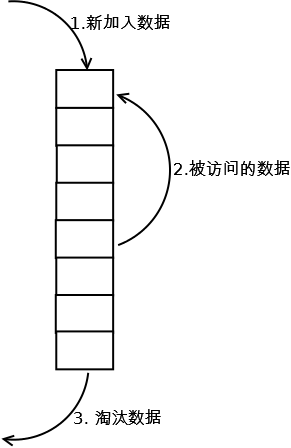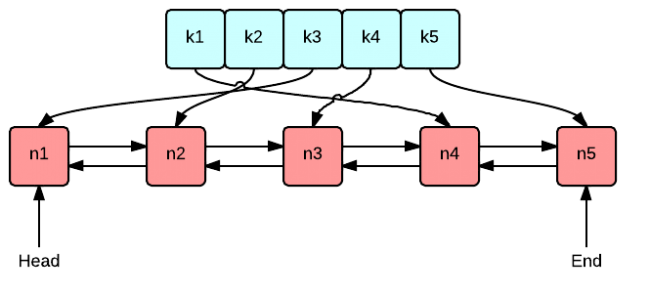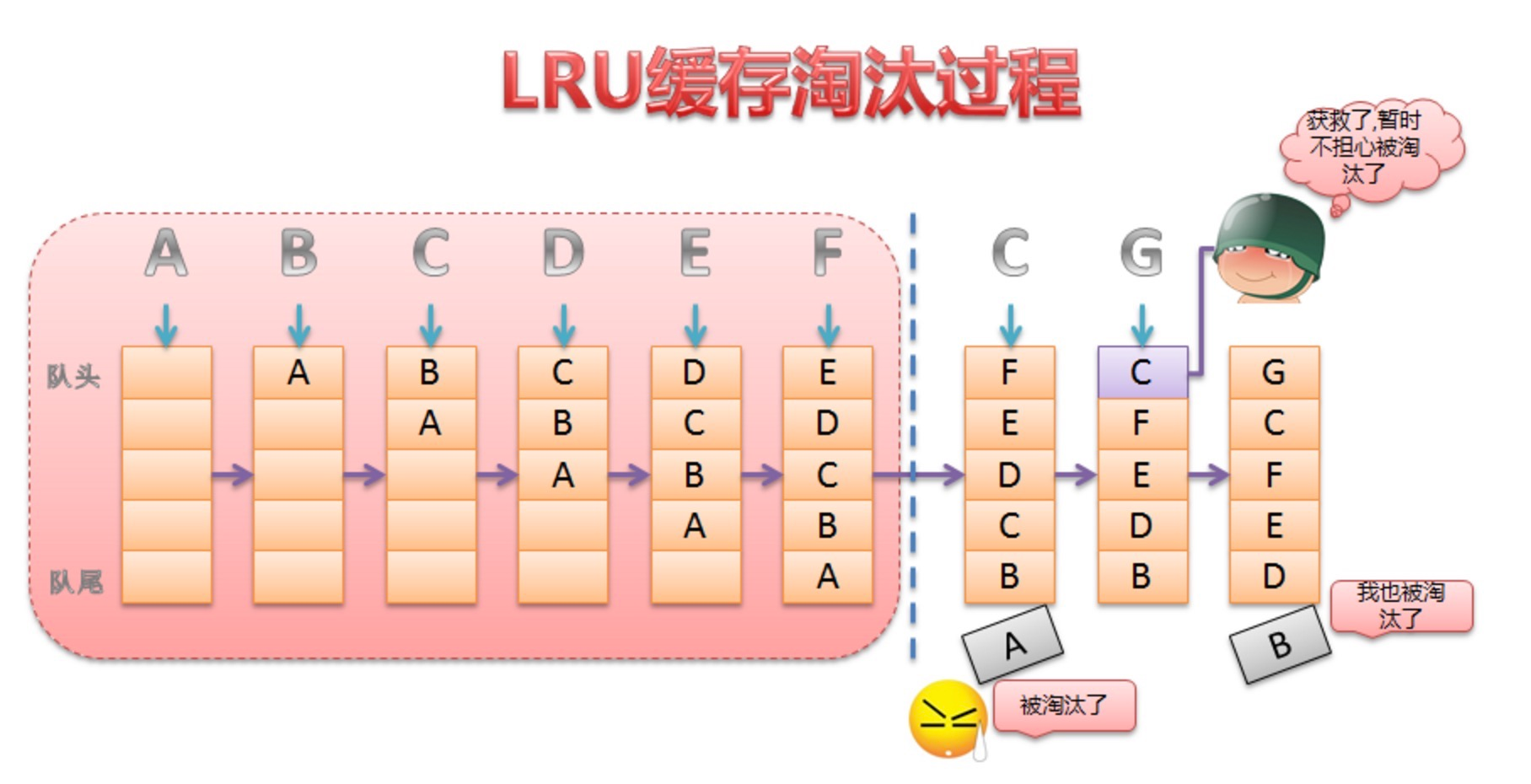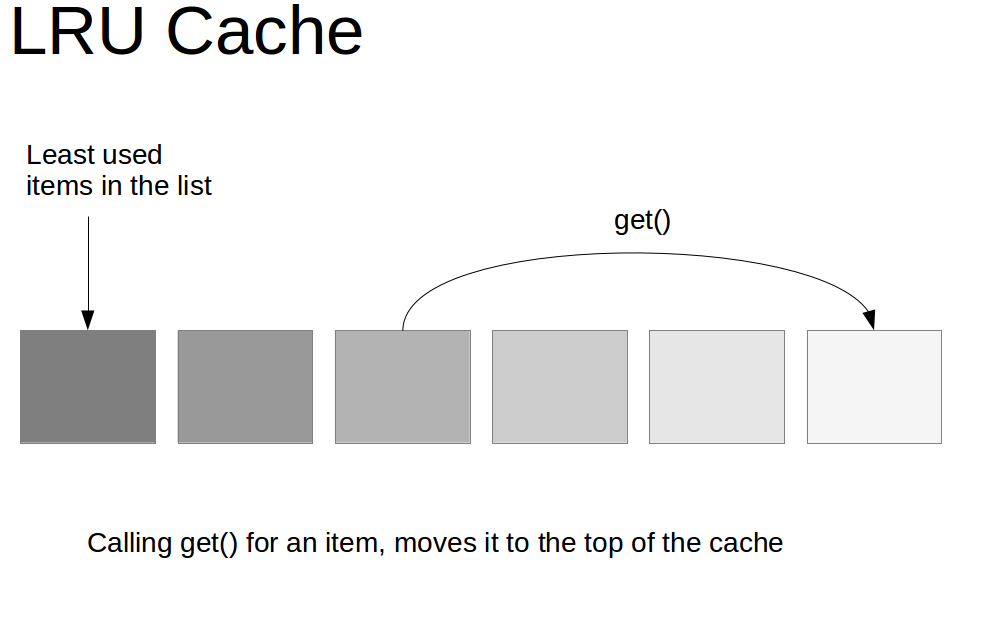一、Android中的缓存策略 一般来说,缓存策略主要包含缓存的添加、获取和删除这三类操作。如何添加和获取缓存这个比较好理解,那么为什么还要删除缓存呢?这是因为不管是内存缓存还是硬盘缓存,它们的缓存大小都是有限的。当缓存满了之后,再想其添加缓存,这个时候就需要删除一些旧的缓存并添加新的缓存。
因此LRU(Least Recently Used )缓存算法便应运而生,LRU是近期最少使用的算法,它的核心思想是当缓存满时,会优先淘汰那些近期最少使用的缓存对象,有效的避免了OOM的出现。在Android中采用LRU算法的常用缓存有两种:LruCache 和DisLruCache,分别用于实现内存缓存和硬盘缓存,其核心思想都是LRU缓存算法。
其实LRU缓存的实现类似于一个特殊的栈,把访问过的元素放置到栈顶(若栈中存在,则更新至栈顶;若栈中不存在则直接入栈),然后如果栈中元素数量超过限定值,则删除栈底元素(即最近最少使用的元素)。详细算法实现如下图:
新数据压入到栈顶;
每当缓存命中(即缓存数据被访问),则将数据移到栈顶;
当栈满的时候,将栈底的数据丢弃。
举个例子演示一下:
二、LruCache的使用 LruCache是Android 3.1所提供的一个缓存类,所以在Android中可以直接使用LruCache实现内存缓存。而DisLruCache目前在Android 还不是Android SDK的一部分,但Android官方文档推荐使用该算法来实现硬盘缓存。
讲到LruCache不得不提一下LinkedHashMap,因为LruCache中Lru算法的实现就是通过LinkedHashMap来实现的。LinkedHashMap继承于HashMap,它使用了一个双向链表来存储Map中的Entry顺序关系,这种顺序有两种,一种是LRU顺序 ,一种是插入顺序 ,这可以由其构造函数public LinkedHashMap(int initialCapacity,float loadFactor, boolean accessOrder)的最后一个参数accessOrder来指定。所以,对于get、put、remove等操作,LinkedHashMap除了要做HashMap做的事情,还做些调整Entry顺序链表的工作。LruCache中将LinkedHashMap的顺序设置为LRU顺序来实现LRU缓存,每次调用get(也就是从内存缓存中取图片),则将该对象移到链表的尾端。调用put插入新的对象也是存储在链表尾端,这样当内存缓存达到设定的最大值时,将链表头部的对象(近期最少用到的)移除。关于LinkedHashMap详解请前往:理解LinkedHashMap
LruCache使用示例 LruCache的使用非常简单,我们就以图片缓存为例:
1 2 3 4 5 6 7 8 int maxMemory = (int ) (Runtime.getRuntime().totalMemory()/1024 );int cacheSize = maxMemory/8 ;mMemoryCache = new LruCache<String,Bitmap>(cacheSize){ @Override protected int sizeOf (String key, Bitmap value) return value.getRowBytes()*value.getHeight()/1024 ; } };
① 设置LruCache缓存的大小,一般为当前进程可用容量的1/8。
注意: 缓存的总容量和每个缓存对象的大小所用单位要一致。
LruCache的实现原理 LruCache的核心思想很好理解,就是要维护一个缓存对象列表,其中对象列表的排列方式是按照访问顺序实现的,即一直没访问的对象,将放在队尾,即将被淘汰。而最近访问的对象将放在队头,最后被淘汰。如下图所示:
那么这个队列到底是由谁来维护的,前面已经介绍了是由LinkedHashMap来维护。
而LinkedHashMap是由数组+双向链表的数据结构来实现的。其中双向链表的结构可以实现访问顺序和插入顺序,使得LinkedHashMap中的<key,value>对按照一定顺序排列起来。
通过下面构造函数来指定LinkedHashMap中双向链表的结构是访问顺序还是插入顺序。
1 2 3 4 5 6 7 8 9 10 11 12 13 14 15 16 17 18 19 20 public LinkedHashMap ( int initialCapacity, float loadFactor, boolean accessOrder) super (initialCapacity, loadFactor); init(); this .accessOrder = accessOrder; }
其中accessOrder设置为true则为访问顺序 ,为false,则为插入顺序 。
以具体例子解释,当设置为true时:
1 2 3 4 5 6 7 8 9 10 11 12 13 14 15 16 public static final void main (String[] args) LinkedHashMap<Integer, Integer> map = new LinkedHashMap<>(0 , 0.75f , true ); map.put(0 , 0 ); map.put(1 , 1 ); map.put(2 , 2 ); map.put(3 , 3 ); map.put(4 , 4 ); map.put(5 , 5 ); map.put(6 , 6 ); map.get(1 ); map.get(2 ); for (Map.Entry<Integer, Integer> entry : map.entrySet()) { System.out.println(entry.getKey() + ":" + entry.getValue()); } }
输出结果如下:
0:0
即最近访问的对象会被放到队尾,然后最后输出,那么这就正好满足的LRU缓存算法的思想。可见LruCache巧妙实现,就是利用了LinkedHashMap的这种数据结构。
下面我们在LruCache源码中具体看看,怎么应用LinkedHashMap来实现缓存的添加,获得和删除的。
LruCache源码分析 我们先看看成员变量有哪些:
1 2 3 4 5 6 7 8 9 10 11 12 13 14 15 public class LruCache <K , V > private final LinkedHashMap<K, V> map; private int size; private int maxSize; private int putCount; private int createCount; private int evictionCount; private int hitCount; private int missCount; }
构造函数如下,可以看到LruCache正是用了LinkedHashMap的accessOrder=true构造参数实现LRU访问顺序:
1 2 3 4 5 6 7 8 public LruCache (int maxSize) if (maxSize <= 0 ) { throw new IllegalArgumentException("maxSize <= 0" ); } this .maxSize = maxSize; this .map = new LinkedHashMap<K, V>(0 , 0.75f , true ); }
put方法 1 2 3 4 5 6 7 8 9 10 11 12 13 14 15 16 17 18 19 20 21 22 23 24 25 26 public final V put (K key, V value) if (key == null || value == null ) { throw new NullPointerException("key == null || value == null" ); } V previous; synchronized (this ) { putCount++; size += safeSizeOf(key, value); previous = map.put(key, value); if (previous != null ) { size -= safeSizeOf(key, previous); } } if (previous != null ) { entryRemoved(false , key, previous, value); } trimToSize(maxSize); return previous; }
可以看到put()方法并没有什么难点,重要的就是在添加过缓存对象后,调用trimToSize()方法,来判断缓存是否已满,如果满了就要删除近期最少使用的算法。
trimToSize方法 1 2 3 4 5 6 7 8 9 10 11 12 13 14 15 16 17 18 19 20 21 22 23 24 25 26 27 28 public void trimToSize (int maxSize) while (true ) { K key; V value; synchronized (this ) { if (size < 0 || (map.isEmpty() && size != 0 )) { throw new IllegalStateException(getClass().getName() + ".sizeOf() is reporting inconsistent results!" ); } if (size <= maxSize || map.isEmpty()) { break ; } Map.Entry<K, V> toEvict = map.entrySet().iterator().next(); key = toEvict.getKey(); value = toEvict.getValue(); map.remove(key); size -= safeSizeOf(key, value); evictionCount++; } entryRemoved(true , key, value, null ); } }
trimToSize()方法不断地删除LinkedHashMap中队头的元素,即近期最少访问的,直到缓存大小小于最大值。
当调用LruCache的get()方法获取集合中的缓存对象时,就代表访问了一次该元素,将会更新队列,保持整个队列是按照访问顺序排序。这个更新过程就是在LinkedHashMap中的get()方法中完成的。
我们先看LruCache的get()方法。
get方法 1 2 3 4 5 6 7 8 9 10 11 12 13 14 15 16 17 18 19 20 21 22 23 24 25 26 27 28 29 30 31 32 33 34 35 36 37 38 39 40 41 42 43 44 45 46 47 48 49 50 51 52 53 54 55 56 57 58 59 60 public final V get (K key) if (key == null ) { throw new NullPointerException("key == null" ); } V mapValue; synchronized (this ) { mapValue = map.get(key); if (mapValue != null ) { hitCount++; return mapValue; } missCount++; } V createdValue = create(key); if (createdValue == null ) { return null ; } synchronized (this ) { createCount++; mapValue = map.put(key, createdValue); if (mapValue != null ) { map.put(key, mapValue); } else { size += safeSizeOf(key, createdValue); } } if (mapValue != null ) { entryRemoved(false , key, createdValue, mapValue); return mapValue; } else { trimToSize(maxSize); return createdValue; } }
其中LinkedHashMap的get()方法如下:
1 2 3 4 5 6 7 8 9 10 public V get (Object key) Node<K,V> e; if ((e = getNode(hash(key), key)) == null ) return null ; if (accessOrder) afterNodeAccess(e); return e.value; }
调用的afterNodeAccess()方法将该元素移到队尾,保证最后才删除,如下:
1 2 3 4 5 6 7 8 9 10 11 12 13 14 15 16 17 18 19 20 21 22 23 24 25 void afterNodeAccess (Node<K,V> e) LinkedHashMap.Entry<K,V> last; if (accessOrder && (last = tail) != e) { LinkedHashMap.Entry<K,V> p = (LinkedHashMap.Entry<K,V>)e, b = p.before, a = p.after; p.after = null ; if (b == null ) head = a; else b.after = a; if (a != null ) a.before = b; else last = b; if (last == null ) head = p; else { p.before = last; last.after = p; } tail = p; ++modCount; } }
由此可见LruCache中维护了一个集合LinkedHashMap,该LinkedHashMap是以访问顺序排序的。当调用put()方法时,就会在结合中添加元素,并调用trimToSize()判断缓存是否已满,如果满了就用LinkedHashMap的迭代器删除队头元素,即近期最少访问的元素。当调用get()方法访问缓存对象时,就会调用LinkedHashMap的get()方法获得对应集合元素,同时会更新该元素到队尾。
以上便是LruCache实现的原理,理解了LinkedHashMap的数据结构就能理解整个原理。如果不懂,可以先看看LinkedHashMap的具体实现。
参考资料




